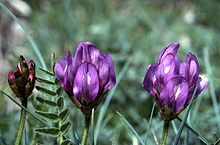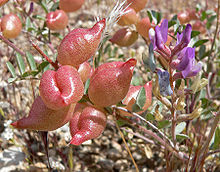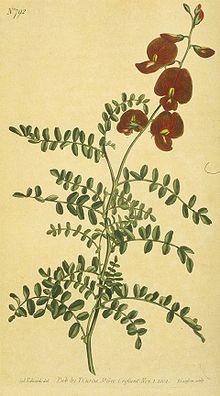- Locoweed
-
For other uses, see Locoweed (disambiguation).
Locoweed (also crazyweed and loco) is a common name in North America for any plant that produces swainsonine, a phytotoxin harmful to livestock. Worldwide, swainsonine is produced by a small number of species, most in three genera of the flowering plant family Fabaceae: Oxytropis and Astragalus in North America,[1] and Swainsona in Australia. The term locoweed usually refers only to the North American species of Oxytropis and Astragalus, but this article includes the other species as well.
Locoweed is relatively palatable to livestock, and some individual animals will seek it out. Livestock poisoned by chronic ingestion of large amounts of swainsonine develop a medical condition known as locoism (also swainsonine disease,[2] swainsonine toxicosis, locoweed disease, and loco disease; North America) and pea struck[3] (Australia). Locoism is reported most often in cattle, sheep, and horses, but has been reported also in elk and deer. It is the most widespread poisonous plant problem in the western United States.[1] Agricultural Research Service and New Mexico State University scientists have been collaborating since 1990 to help solve the problem that locoweed presents to livestock farmers. The research involved identifying the fungal species that produces the locoweed toxins, pinpointing levels of toxicity in animals once they have ingested locoweed, observing the effects of locoweed toxins on livestock’s reproduction and grazing preferences, etc. Together, the scientists assembled a grazing management scheme to help farmers avoid the poisonous locoweed.[4]
Most of the 2000 species of Astragalus, including many that are commonly known as locoweeds, do not produce swainsonine. Some species, including a few that produce swainsonine, accumulate selenium. This has led to confusion between swainsonine poisoning and selenium poisoning due to this genus.
Contents
History and etymology
The first technical account (in English) of locoism was published in 1873, in the United States. Linguists have documented locoism in use among English speakers by 1889, and both loco and locoweed in use by 1844.[5]
Loco, a loanword from Spanish, is understood by most English-speaking users in the sense of crazy, and this appears to have also been the sense understood by vaqueros.[5] In Spanish, however, loco has an older, different sense. In Spain, where the native Astragalus species are not known to cause locoism, for centuries loco has been applied to some of these species in the sense of rambling: common names include yerba loca (hierba loca; rambling herb) and chocho loco (rambling lupine).
Locoweed is a compound of loco and weed. Although some authors claim it is incorrect to use loco as a noun (in place of locoweed), this usage has a long history.
The presence of a toxin in locoweed was demonstrated in 1909. Initially, the toxin was reported to be barium, but that was soon disproved. Swainsonine, first isolated from Swainsona, was shown to be responsible for pea struck in 1979, and was reported in both Oxytropis and Astragalus in 1982.[6]
Since 1982, swainsonine has been isolated from still more plants, some of which also are reported to cause locoism or medical conditions similar to locoism. The first report of locoism in South America, involving Astragalus pehuenches, was published in 2000.[7]
Taxa producing swainsonine
Swainsonine is produced by a small number of species, including species in several genera of plants and two genera of fungi.
Oxytropis is distributed throughout western North America, particularly in the Great Plains and Rocky Mountains. However, most species of Oxytropis have narrow habitat requirements and within those habitats are abundant only in unusually wet years.[1] The species most frequently encountered by livestock are O. lambertii (Lambert locoweed, purple locoweed, woolly locoweed) and especially Oxytropis sericea (white locoweed, white point locoweed, white point loco). Swainsonine has also been found in O. campestris (in Canada).[8]
Some species of Astragalus (milkvetch) are also referred to as locoweed. These are primarily species which grow in areas with high selenium content in the soil.[citation needed] Swainsonine has been found in:[8]
- A. earlei (Big Bend loco)
- A. mollissimus (purple woolly loco)
- A. pubentissimus (green river milkvetch)
- A. lentigenosis (spotted locoweed, freckled milkvetch)
- A. wootoni (garbancillo)
- A. nothoxys (beaked milkvetch)
- A. tephrodes (ashen milkvetch)
- A. humistratus (ground cover milkvetch)
In Argentina, locoism (locoismo) was first reported in 2000. A flock of sheep grazing a pasture with Astragalus pehuenches was poisoned and 220 sheep (73%) died.[7] Although this was the first report of locoism in South America,[7] swainsonine had been isolated previously from A. pehuenches and several other species in Argentina and Peru.[7][9]
In the Old World, native plants causing locoism have not been reported. Astragalus lusitanicus in Morocco was suspected,[10] but has been shown be neither a producer of swainsonine nor an accumulator of selenium. Its toxicity is suspected to be due to a novel alkaloid.[11] In Spanish, common names of this species include altramuz loco, chochos locos, garbanzo del diablo, and garbancillo.
In Australia, species of Swainsona (Darling pea) that cause pea struck include:[8][12]
- S. luteola
- S. greyana
- S. galegifolia (smooth Darling pea)
Astragalus and Oxytropis are 2 of 20 genera (and 78 names of genera) in the tribe Galegeae, subtribe Astragalinae. Some authorities include Swainsona in the subtribe.[13] Formerly, Swainsona was in another subtribe, Coluteinae, that has been combined into Astragalinae.
Swainsonine has also been isolated from Sida carpinifolia and Ipomea carnea, and both species have been reported to cause locoism.[14]
Embellisia, a fungus isolated from Oxytropis lambertii, has also been shown to produce swainsonine and to cause locoism in rats.[15] Rhizoctonia leguminicola, a fungal plant pathogen that may occur on red clover, also produces swainsonine. Although intoxication due to this fungus resembles locoism, it has additional signs and symptoms due to the production of other toxins.[16]
Epidemiology
Locoweed is eaten during the early spring and late fall, when it is often the only green plant available to grazing animals.
Pathology
Intoxication with swainsonine has several kinds of effect.
Livestock that graze for several weeks on locoweed (and little else) develop a lysosomal storage disease similar to genetic mannosidosis.[17] Swainsonine inhibits a lysosomal enzyme, alpha-mannosidase.[18] This results in abnormal accumulation of the molecules normally processed by the enzyme, and this accumulation leads to vacuolation of most tissues. Vacuolation is most obvious in neurons and epithelial cells. The vacuolation resolves shortly after poisoning is discontinued, but if the vacuolation is so severe that it destroys cells, it may result in some neurologic damage that is irreversible and permanent.[17] The damage is highly varied.
In cattle at high altitude, complications of locoism can include congestive heart failure.[19]
In cattle, sheep, and goats, locoweed poisoning causes reproductive losses.
Diagnosis
Diagnosis of clinical poisoning is generally made by documenting exposure, identifying the neurologic signs, and analyzing serum for alpha-mannosidase activity and swainsonine.[17]
In mule deer, clinical signs of locoism are similar to chronic wasting disease. Histological signs of vacuolation provide a differential diagnosis.[20]
Sub-clinical intoxication has been investigated in cattle grazing on Astragalus mollissimus. As the estimated intake of swainsonine increased, blood serum alpha-mannosidase activity and albumin decreased, and alkaline phosphatase and thyroid hormone increased.[21]
Prevention
Because O. sericea is both frequently encountered and relatively palatable to livestock, it is an important cause of economic losses in livestock production. Keeping livestock away from locoweed infested pasture in spring and fall when grass and other forbs not actively growing is recommended. Another suggested remedy is to provide palatable supplemental nutrients if animals are to be kept in infested pasture. These remedies take into account livestock preference for locoweed during seasons when grass is dry and not very nutritious.[22] Conditioned food aversion has been used experimentally to discourage livestock from eating it.[23][24] In horses, a small study has shown promising results using lithium chloride as the aversive agent.[24]
How to Reduce Losses: Restrict access to locoweed during critical periods when the plant is more palatable than associated forages. Maintain conservative stocking rates to avoid forcing animals to consume locoweed when desirable forage becomes limited. Remove animals that begin eating locoweed to prevent intoxication and to keep them from influencing others to start eating locoweed. No treatments have been identified that are effective in reversing or minimizing locoweed poisoning.[25]
Locoweed can be controlled by spraying actively growing or budding plants with clopyralid (20-30 gm ae/Ac), picloram (250 gm ai/Ac), and metsulfuron (30 gm ai/Ac). If plants are scattered, treatment of individual plants or patches may be practical. Follow precautions when handling herbicides.[25]
See also
References
- ^ a b c Ralphs MH, James LF (February 1999). "Locoweed grazing". Journal of Natural Toxins 8 (1): 47–51. PMID 10091127.
- ^ Jones et al. (1997), page 39.
- ^ Pritchard DH, Huxtable CR, Dorling PR (March 1990). "Swainsonine toxicosis suppresses appetite and retards growth in weanling rats". Research in Veterinary Science 48 (2): 228–30. PMID 2110378.
- ^ http://www.ars.usda.gov/is/pr/2010/100621.htm
- ^ a b Robert N. Smead and Richard W. Slatta (2004). Vocabulario Vaquero/cowboy Talk: A Dictionary Of Spanish Terms From The American West. University of Oklahoma Press. pp. 197. ISBN 0806136316. http://books.google.com/?id=MR4SY5n3_L8C. page 115
- ^ Keeler and Tu (1983), page 454.
- ^ a b c d C.A. Robles, C. Saber, M. Jefrey (2000). "Intoxicación por Astragalus pehuenches (locoismo) en ovinos Merino de la Patagonia Argentina". Rev. Med. Veterinaria 81 (5): 380–384. http://www.inta.gov.ar/bariloche/info/documentos/animal/salud/pa384.htm.
- ^ a b c Jones et al. (1997), page 752.
- ^ Michael JP (December 1997). "Indolizidine and quinolizidine alkaloids". Natural Product Reports 14 (6): 619–36. doi:10.1039/NP9971400619. PMID 9418297. http://www.rsc.org/Publishing/Journals/NP/article.asp?doi=NP9971400619. Retrieved 2009-05-14.
- ^ Abdennebi EH, el Ouazzani N, Lamnaouer D (December 1998). "Clinical and analytical studies of sheep dosed with various preparations of Astragalus lusitanicus". Veterinary and Human Toxicology 40 (6): 327–31. PMID 9830691.
- ^ Ouazzani N, Lamnaouer D, Abdennebi EH (1999). "Toxicology of Astragalus lusitanicus Lam". Thérapie 54 (6): 707–10. PMID 10709444.
- ^ Les Tanner (August 2003). "Poisonous plant: Darling pea (Swainsona spp.)". Northern Inland Weeds Advisory Committee. http://www.northwestweeds.nsw.gov.au/Poisonous%20plants%20label%20-%20darling%20pea.pdf. Retrieved 2009-05-11.
- ^ "GRIN Genera of Fabaceae subtribe Astragalinae". Germplasm Resources Information Network. 2003. http://www.ars-grin.gov/cgi-bin/npgs/html/gnlist.pl?1504. Retrieved 2009-05-12.
- ^ Carod-Artal FJ (2003). "[Neurological syndromes linked with the intake of plants and fungi containing a toxic component (I). Neurotoxic syndromes caused by the ingestion of plants, seeds and fruits"] (in Spanish; Castilian). Revista De Neurologia 36 (9): 860–71. PMID 12717675. http://www.revneurol.com/LinkOut/formMedLine.asp?Refer=2003018&Revista=Revneurol. Retrieved 2009-05-13.
- ^ McLain-Romero J, Creamer R, Zepeda H, Strickland J, Bell G (July 2004). "The toxicosis of Embellisia fungi from locoweed (Oxytropis lambertii) is similar to locoweed toxicosis in rats". Journal of Animal Science 82 (7): 2169–74. PMID 15309966. http://jas.fass.org/cgi/pmidlookup?view=long&pmid=15309966. Retrieved 2009-05-13.
- ^ Croom WJ, Hagler WM, Froetschel MA, Johnson AD (May 1995). "The involvement of slaframine and swainsonine in slobbers syndrome: a review". Journal of Animal Science 73 (5): 1499–508. PMID 7665382. http://jas.fass.org/cgi/pmidlookup?view=long&pmid=7665382. Retrieved 2009-05-13.
- ^ a b c Stegelmeier BL, James LF, Panter KE, Ralphs MH, Gardner DR, Molyneux RJ, Pfister JA (February 1999). "The pathogenesis and toxicokinetics of locoweed (Astragalus and Oxytropis spp.) poisoning in livestock". Journal of Natural Toxins 8 (1): 35–45. PMID 10091126.
- ^ Jones et al. (1997), page 31.
- ^ "High-mountain Disease: Introduction". The Merck Veterinary Manual. 2008. http://www.merckvetmanual.com/mvm/index.jsp?cfile=htm/bc/11400.htm. Retrieved May 11, 2009.
- ^ Stegelmeier BL, James LF, Gardner DR, Panter KE, Lee ST, Ralphs MH, Pfister JA, Spraker TR (September 2005). "Locoweed (Oxytropis sericea)-induced lesions in mule deer (Odocoileius hemionus)". Veterinary Pathology 42 (5): 566–78. doi:10.1354/vp.42-5-566. PMID 16145203.
- ^ Stegelmeier BL, Ralphs MH, Gardner DR, Molyneux RJ, James LF (October 1994). "Serum alpha-mannosidase activity and the clinicopathologic alterations of locoweed (Astragalus mollissimus) intoxication in range cattle". Journal of Veterinary Diagnostic Investigation : Official Publication of the American Association of Veterinary Laboratory Diagnosticians, Inc 6 (4): 473–9. PMID 7858027.
- ^ "ARS and New Mexico Scientists Take a Long Look at Livestock and Locoweed" by Ann Perry June 21, 2010 Agricultural Research Service, accessed September 29, 2010
- ^ Ralphs MH, Provenza FD (November 1999). "Conditioned food aversions: principles and practices, with special reference to social facilitation". The Proceedings of the Nutrition Society 58 (4): 813–20. doi:10.1017/S002966519900110X. PMID 10817148. http://journals.cambridge.org/abstract_S002966519900110X. Retrieved 2009-05-11.
- ^ a b Pfister JA, Stegelmeier BL, Cheney CD, Ralphs MH, Gardner DR (January 2002). "Conditioning taste aversions to locoweed (Oxytropis sericea) in horses". Journal of Animal Science 80 (1): 79–83. PMID 11831531. http://jas.fass.org/cgi/pmidlookup?view=long&pmid=11831531. Retrieved 2009-05-13.
- ^ a b "Locoweed (Astragalus and Oxytropis spp.)" Agricultural Research Service, quotation in the public domain as the product of an employee of the United States made during performance of their duties, accessed September 29, 2010
- Jones, T. C., R. D. Hunt, and N. W. King (1997). Veterinary pathology (6th ed.). Wiley-Blackwell. pp. 1392. ISBN 0683044818, 9780683044812. http://books.google.com/?id=8fXzJrDfFgUC.
- Keeler, R. F. and A. T. Tu, ed (1983). Plant and fungal toxins. Marcel Dekker. pp. 934. ISBN 0824718933. http://books.google.com/?id=DtUO6fgC4w4C.
External links
- White Locoweed - Kansas State University
- Purple LocoWeed - Kansas State University
- Purple Locoweed - United States Department of Agriculture
- Locoweed - ARS/USDA
- Astragalus species of locoweed - Utah State University
Poisonings, toxicities, and overdoses (T36–T65, 960–989) (history) Inorganic Organic CHOPharmaceuticals cardiovascular systemBiological
(including venom,
toxin,
food poisoning)Fish/seafoodOther vertebratesList of biting or stinging arthropods: bee sting/bee venom (Apamin, Melittin) · spider venom (Latrotoxin/Latrodectism, Loxoscelism) · scorpion venom (Charybdotoxin)Mushroom poisoning · Lathyrism · Ergotism · Strychnine poisoning · Cinchonism · Locoism (Pea struck)Categories:- Legumes
- Astragalus
- Oxytropis
- Swainsona
- Drugs acting on the nervous system
- Poisonous plants
- Intoxication
Wikimedia Foundation. 2010.



